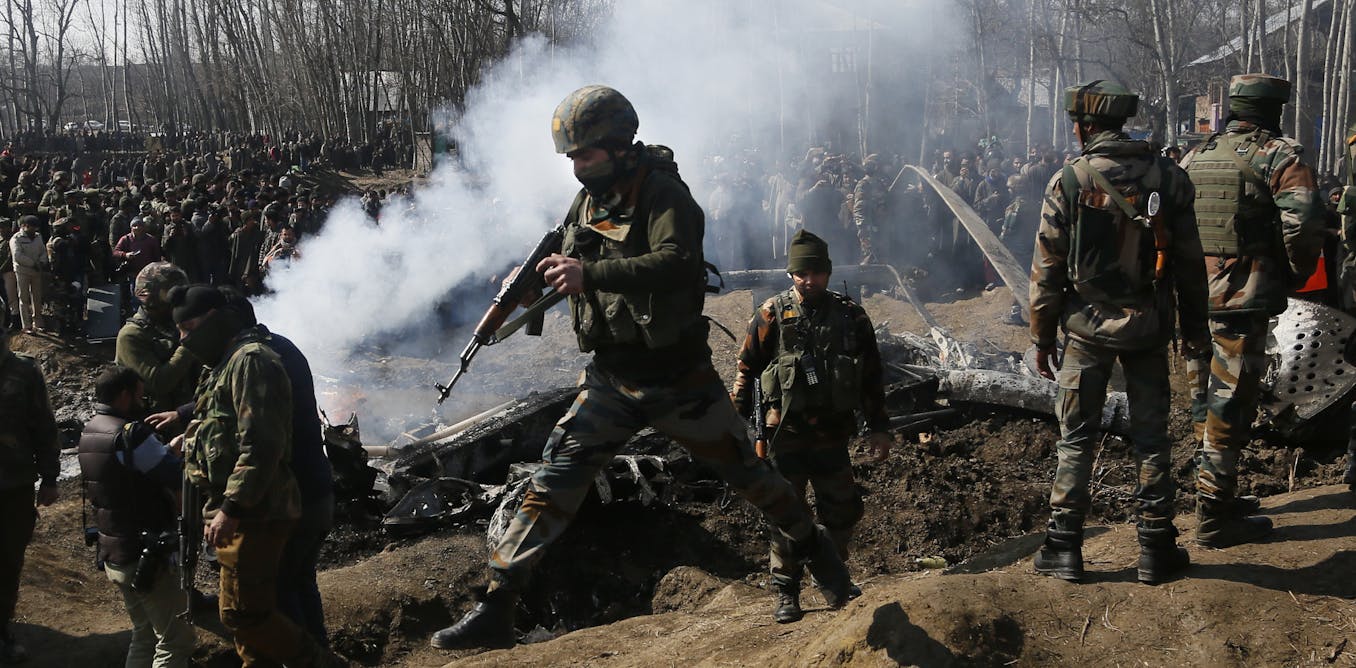How the Partition Sparked Decades of Conflict in Kashmir the serene valleys of Kashmir, once a symbol of harmony and natural splendor, have become synonymous with decades of unrest, geopolitical disputes, and human suffering. Nestled between India, Pakistan, and China, this strategically significant region has been at the heart of South Asia’s longest-running conflict. And the origin of this conflict can be traced back to a pivotal historical event: the partition of India and Pakistan.

A Land Divided: Setting the Stage for Discord
In 1947, the British Empire dismantled its rule in the Indian subcontinent. What followed was the hurried and chaotic partition of India and Pakistan, creating two nations along religious lines—India, largely Hindu, and Pakistan, conceived as a homeland for Muslims. This seismic event displaced nearly 15 million people and led to the death of over a million in communal violence.
Kashmir, however, did not neatly fall into this binary division. A princely state with a Muslim-majority population ruled by a Hindu Maharaja, Hari Singh, it faced an existential dilemma. Would it accede to India or Pakistan—or remain independent?
The Instrument of Accession and the First War
Initially, Maharaja Hari Singh opted for neutrality, resisting accession to either dominion. But in October 1947, tribal militias from Pakistan invaded Kashmir, prompting the Maharaja to request military help from India. India agreed—on the condition that Kashmir accede to it officially.
Thus, the partition of India and Pakistan indirectly ignited the first Indo-Pakistani war. Although a ceasefire was brokered by the United Nations in 1949, the damage was done. Kashmir was split between India and Pakistan, with the Line of Control (LoC) becoming the de facto border, sowing the seeds of future conflict.
A Disputed Territory: The Brewing Storm
From the 1950s onward, the Kashmir region became a geopolitical powder keg. Pakistan insisted that since the majority of Kashmiris were Muslim, the territory rightfully belonged to them. India countered that the Maharaja had legally acceded to India and that Kashmir was an integral part of its democratic, secular framework.
The United Nations proposed a plebiscite to allow Kashmiris to decide their fate, but this never materialized. Both nations dug in their heels, and the region remained heavily militarized.
The unresolved status of Kashmir created an enduring flashpoint that led to further wars in 1965 and 1999, not to mention numerous skirmishes, infiltration attempts, and proxy wars over the decades. The partition of India and Pakistan didn’t just split two nations—it fractured an entire region’s psyche.
The Rise of Insurgency in the 1990s
By the late 1980s, discontent among the Kashmiri population had reached a boiling point. Economic stagnation, political manipulation, and alleged human rights violations by Indian forces catalyzed a new phase of the conflict—armed insurgency.
Youth across the Valley picked up arms, some inspired by ideology, others driven by despair. Pakistan was accused of providing moral and material support to these militants, turning Kashmir into a theatre of proxy war. In response, India increased its military presence exponentially.
The result was a devastating decade of bloodshed, disappearances, and mass displacement. The insurgency tore apart the social fabric of Kashmir, and the echoes of the partition of India and Pakistan reverberated louder than ever.
Human Rights and Civilian Suffering
At the heart of the Kashmir conflict lies an often-overlooked narrative—the suffering of ordinary people. Caught between crossfire, curfews, and suspicion, Kashmiri civilians have borne the brunt of the decades-long unrest.
Numerous reports from international human rights organizations have highlighted issues ranging from enforced disappearances to extrajudicial killings and the use of pellet guns. Meanwhile, suicide bombings, targeted killings, and attacks on minorities within Kashmir further complicate the moral landscape.
The partition of India and Pakistan created not just borders, but also a legacy of distrust and dehumanization. While politicians debate sovereignty, the people of Kashmir continue to yearn for dignity, justice, and peace.
Cultural Unity vs Political Division
Interestingly, despite the geopolitical rivalry, Kashmir continues to reflect cultural and emotional ties to both India and Pakistan. Shared language, music, cuisine, and heritage connect Kashmiris across the Line of Control.
Families separated by the partition of India and Pakistan still attempt to keep in touch through letters, internet calls, and the occasional diplomatic breakthrough that allows cross-border bus services or trade routes to open briefly.
Yet these moments of unity are often fleeting, overwhelmed by rising tensions, diplomatic breakdowns, and terrorist incidents. The enduring challenge is to find a framework that respects the people’s cultural fabric while resolving political disputes through peaceful means.
The Role of Religion and Identity Politics
One of the defining consequences of the partition of India and Pakistan is the heightened politicization of religion. Kashmir, a multi-religious and multi-ethnic land, found itself thrust into a binary of Hindu India versus Muslim Pakistan.
Over time, both nations utilized religion as a tool for narrative-building. In Pakistan, Kashmir is often portrayed as an unfinished agenda of partition. In India, integration of Kashmir is tied to national identity and sovereignty.
This polarizing lens overshadows the fact that many Kashmiris seek self-determination not solely based on religion, but based on historical autonomy, economic freedom, and political agency. The binary overlooks the region’s complexity and perpetuates a cycle of simplistic, adversarial thinking.
Nuclear Neighbors: A Fragile Balance
India and Pakistan are both nuclear powers, making the Kashmir conflict one of the most dangerous in the world. In 1999, the Kargil War brought both countries perilously close to a full-scale nuclear confrontation.
In this context, the partition of India and Pakistan continues to cast a long and dangerous shadow. A localized skirmish in Kashmir could spiral into a global crisis. International actors, including the United States, China, and the United Nations, have intermittently tried to mediate, but substantive resolution remains elusive.
Nuclear diplomacy has largely focused on deterrence. But real peace requires more than strategic balance—it demands political will, mutual trust, and a commitment to non-violence.
Media Narratives and Misinformation
The digital age has turned Kashmir into a battleground of narratives. National media in both India and Pakistan often amplify the most extreme positions, leaving little room for nuance.
Misinformation spreads like wildfire, further polarizing societies. Social media, while giving a voice to the voiceless, also magnifies fake news, doctored videos, and conspiracy theories.
The partition of India and Pakistan is often romanticized or weaponized in these narratives, depending on which side of the border the story originates. To move toward resolution, a shift toward responsible journalism and truth-telling is imperative.
Article 370 and the New Normal
In 2019, India abrogated Article 370 of its Constitution, stripping Jammu and Kashmir of its special status. This bold move was celebrated in some circles as an act of national integration. In others, it was seen as a provocation and a betrayal of Kashmir’s unique identity.
The region was placed under a security lockdown, communication lines were cut, and political leaders were detained. International reactions were mixed, but it reignited questions about autonomy, human rights, and constitutional commitments.
This moment once again reminded the world how the partition of India and Pakistan continues to influence contemporary policymaking. Kashmir is not just a relic of 1947—it is a living, breathing issue that affects millions in real time.
Education and Dialogue: Paths to Peace
Despite the decades of conflict, there are signs of hope. Across Kashmir, education is emerging as a transformative force. Young people are eager to build futures unshackled by the past. Teachers, activists, and entrepreneurs are creating spaces for learning, healing, and innovation.
Cross-border student exchanges, peace-building workshops, and cultural festivals have the potential to replace fear with familiarity. When young Indians, Pakistanis, and Kashmiris engage in dialogue, stereotypes are broken and empathy is born.
Educational reform that includes a balanced and honest account of the partition of India and Pakistan—its causes, consequences, and costs—can foster a more informed and compassionate generation.
Toward a Shared Tomorrow
The story of Kashmir is not one of eternal doom. It is a tale of resilience, of people who continue to hope in the face of hardship. The partition of India and Pakistan was a moment in history that sparked a fire—but it doesn’t have to define the future.
Healing will take time. It will require courage from leaders, empathy from citizens, and solidarity from the international community. But most of all, it will require the acknowledgment that behind every policy, every skirmish, and every map line, there are human lives at stake.
Let the next chapter of Kashmir’s story be one not of war and division, but of cooperation, creativity, and peace. Let the valleys echo not with gunfire, but with laughter, poetry, and the music of reconciliation.



More Stories
Kashmir Dispute: How It All Began
5 Online Learning Management Systems That Deliver Results
Must-Have Online Learning Tools for Every Student